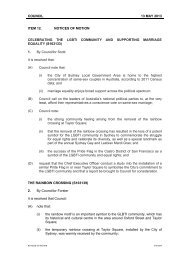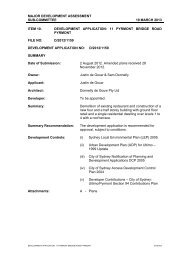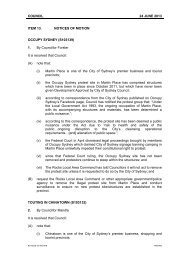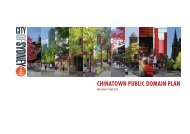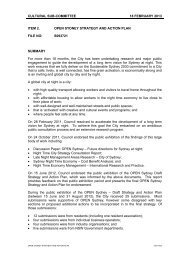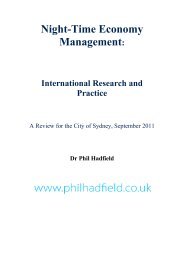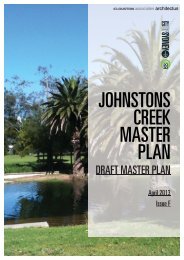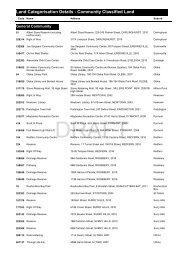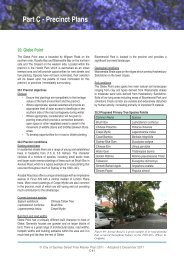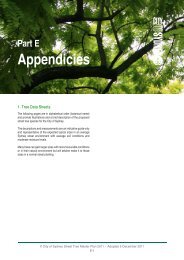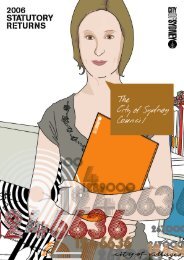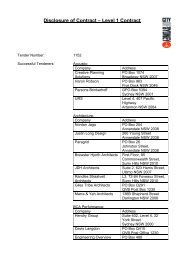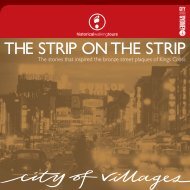Histories of Green Square - City of Sydney
Histories of Green Square - City of Sydney
Histories of Green Square - City of Sydney
Create successful ePaper yourself
Turn your PDF publications into a flip-book with our unique Google optimized e-Paper software.
<strong>Histories</strong> <strong>of</strong> <strong>Green</strong> <strong>Square</strong><br />
Fig. 3.1 <strong>Sydney</strong> and Environs: Average annual rainfall (Source:<br />
Howell & Benson, <strong>Sydney</strong>’s Bushland, 2000, p.13, courtesy<br />
Doug Benson.)<br />
Variations in the vegetation between <strong>Sydney</strong> Cove and Botany<br />
Bay were also noted early in 1788. Between the 26 th and 28 th<br />
February, Captain Hunter, upon finding the seas too rough to<br />
return to <strong>Sydney</strong> by boat, made his way overland with another<br />
<strong>of</strong>ficer and two seamen ‘through the woods and swamps, <strong>of</strong><br />
which there were many in our route’. 4 Historian Joan Lawrence<br />
describes their trek:<br />
24<br />
...they used a pocket compass as an aid and said <strong>of</strong><br />
the land some two miles south <strong>of</strong> Port Jackson that it<br />
‘abounds with high trees, and little or no underwood;<br />
but between that and Botany Bay, it is all thick, low<br />
woods or shrubberies, barren heaths, and swamps, the<br />
land near the sea, although covered in many places<br />
with wood, is rocky from the water-side to the very<br />
summit <strong>of</strong> the hills. 5<br />
In 1790 a search party was sent out by Governor Philip to kill<br />
a number <strong>of</strong> the Aboriginal people living on the north side<br />
<strong>of</strong> Botany Bay, in retaliation for the alleged murder <strong>of</strong> John<br />
McEntire by an Aboriginal man, Pemulwuy (see Chapter 5).<br />
Tim Flannery recounts the tetchy and ironic observations <strong>of</strong><br />
the terrain by Lieutenant Watkin Tench, who was ordered to<br />
take part in this expedition:<br />
...Our march ended at sunset, without our seeing a<br />
single native. We had passed through the country<br />
which the discoverers <strong>of</strong> Botany Bay extol as ‘some<br />
<strong>of</strong> the finest meadows in the world’. These meadows<br />
instead <strong>of</strong> grass, are covered with high coarse rushes,<br />
growing in a rotten spongy bog, into which we were<br />
plunged knee-deep at every step. 6<br />
Tench also noted the flora and fauna <strong>of</strong> the area in his<br />
journal. They included the once common Cabbage Tree Palm<br />
(Livistona australis): ‘That species <strong>of</strong> palm tree which produces<br />
the mountain cabbage is also found in most <strong>of</strong> the freshwater<br />
swamps, within six or seven miles from the coast’. The Swamp<br />
Wallaby Tench described as ‘the red kangaroo, from the colour<br />
<strong>of</strong> its fur, which is like that <strong>of</strong> a hare, and sometimes is mingled<br />
with a large portion <strong>of</strong> black: the natives call it bagary’. He<br />
also pointed out that, besides being an important food source<br />
for Aboriginal people, bagary’s greatest destroyer was the<br />
dingo. Tench sighted emu, which he named cassowary: ‘We<br />
came suddenly upon them, and they ran up a hill exactly like<br />
a flock <strong>of</strong> turkeys, but so fast that we could not get a shot at<br />
them’. The emus were feeding upon ‘either grass or a yellow<br />
bell-flower growing in the swamps’. He also found numerous<br />
reptiles there. 7<br />
To the casual European observer, the Botany Basin, including<br />
<strong>Green</strong> <strong>Square</strong>, appeared inaccessible and useless because it<br />
did not <strong>of</strong>fer land desirable for cultivation or grazing. Open<br />
park-like country was preferred, something they <strong>of</strong>ten identified<br />
with ‘gentlemen’s parks in England’ and most suitable for<br />
grazing. The inhospitable nature <strong>of</strong> this un-European environmental<br />
landscape was later described by Thomas Woore,<br />
who also made observations in the vicinity <strong>of</strong> <strong>Green</strong> <strong>Square</strong>.<br />
He described the area that includes Waterloo Swamp while on<br />
an expedition with Baron Carl von Hugel between 1833 and<br />
1834:<br />
…Our principle object was the collection <strong>of</strong> aquatic<br />
plants, which at that time grew in considerable variety,<br />
as a great part <strong>of</strong> the surface was covered with water.<br />
This occupation led us over almost every part <strong>of</strong> the<br />
swamp that we could obtain footing on; but it was very<br />
difficult to travel, and in many places impossible to do<br />
so, from its semi-liquid state...Much stunted timber<br />
and some large trees were at that time growing on the<br />
sand slopes in sheltered hollows, and the whole was<br />
covered with a thick coat <strong>of</strong> brushwood, that effectually<br />
prevented the sun’s rays and hot winds from penetrating<br />
to the surface... I have now many specimens<br />
<strong>of</strong> Utricularia and other plants <strong>of</strong> a similar nature we<br />
collected there, that can only exist in quagmires. 8<br />
These early observations present the area as a hazardous and<br />
uninviting environment, by highlighting its rugged swampiness.<br />
However, they do provide an important insight into the<br />
great abundance <strong>of</strong> native plant and animal life that existed<br />
there. Birds were particularly attracted to the large supply<br />
<strong>of</strong> fresh water. This environment was formed as a result <strong>of</strong> a<br />
unique combination <strong>of</strong> natural environmental factors.<br />
3.3 Natural environmental factors<br />
3.3.1 Geomorphology<br />
<strong>Sydney</strong> is renowned for its Hawkesbury Sandstone, which<br />
covers a wide geographical area that includes the Botany Basin.<br />
It is massive in nature, the result <strong>of</strong> a uniform deposital phase<br />
<strong>of</strong> Permian and Triassic age (270–180 million years ago), in<br />
which over the millennia sediments were laid down in a freshwater<br />
alluvial environment. 9 The Hawkesbury Sandstone <strong>of</strong><br />
the Botany Basin is overlain with Quaternary sand deposits.<br />
Erosion by wind and water continuously reshaped this<br />
landform.<br />
© Jason Doran<br />
3.3.2 Geology<br />
The Quaternary Period (the last 1.8 million years) is the most<br />
recent stage in landscape development and during this time<br />
‘dune sands were blown inland from the coast where today’s<br />
southern and eastern suburbs lie’. 10 It is this sand that constitutes<br />
much <strong>of</strong> the soil around <strong>Green</strong> <strong>Square</strong> today. These sands<br />
mainly overlie a bedrock <strong>of</strong> Hawkesbury Sandstone, except for<br />
along the southern margin <strong>of</strong> the Botany Basin, where they rest<br />
on Wianamatta Shale. The thickness <strong>of</strong> sediment in the Basin<br />
varies from about a metre or so, to a maximum <strong>of</strong> seventy-five<br />
metres in the channel <strong>of</strong> the Georges River. 11 Hawke defines<br />
these sediments more precisely as:<br />
…dominantly <strong>of</strong> fine-grained, uniform quartzose<br />
porous and permeable sands interspersed with thin,<br />
discontinuous impermeable lenses <strong>of</strong> clay, peat and<br />
“Waterloo rock” (weakly cemented ferruginous<br />
sands). They overlie the relatively impervious Triassic<br />
Wianamatta Group and Hawkesbury Sandstone<br />
bedrock... The basin sand deposits are a product <strong>of</strong><br />
rising sea levels in the Late Quaternary which have<br />
sorted and moved back formerly more easterly terrestrial<br />
deposits and redeposited them in coastal depressions.<br />
The depression in this case was provided by the<br />
basin and the former large estuarine system in it. The<br />
deposits are probably related to more than one change<br />
in sea level. 12<br />
The Eastern Suburbs as a whole is covered by these Quaternary<br />
and Pleistocene sands and clays. Aeolian sands occur at <strong>Green</strong><br />
<strong>Square</strong>, while estuarine silts and clays occur along nearby<br />
Shea’s Creek. Soil type, including moisture content, affects<br />
the distribution and diversity <strong>of</strong> the native flora and fauna<br />
that thrived in this environment. Disturbing this geology by<br />
improving soil quality can upset the fine adaptive balance that<br />
the ESBS achieved, and needs in order to survive.<br />
3.3.3 Soils<br />
The soils on the Quaternary alluvium <strong>of</strong> the Botany Basin<br />
and <strong>Green</strong> <strong>Square</strong> can vary in nature. Loamy soils (containing<br />
sand, clay and organic matter) are found on younger<br />
sediments, though simple pr<strong>of</strong>iles <strong>of</strong> siliceous sands are more<br />
common, particularly around <strong>Green</strong> <strong>Square</strong>. Benson and<br />
Howell point out that ‘slightly more phosphorus is found<br />
in the soils derived from shales than in those derived from<br />
sandstone but the biggest differences in quality between these<br />
relate to soil structure and the ability <strong>of</strong> the heavier textured<br />
soils to retain more soil moisture’. 13 The soil quality is also<br />
very ‘poor’ because it is lacking in the nutrients that European<br />
plants need to survive, and like most <strong>of</strong> Australia’s soils, they<br />
are acidic.<br />
3.3.4 Hydrologic regime<br />
The <strong>Green</strong> <strong>Square</strong> Town Centre is situated� on reclaimed land<br />
that was once known as Waterloo Swamp. Waterloo Swamp<br />
and the swampland that still exists in Centennial Park and at<br />
Eastlakes Golf Course are the result <strong>of</strong> the hydrology <strong>of</strong> the<br />
Botany Basin Sand Beds (see also Chapter 4.0). These are<br />
defined by the quantity <strong>of</strong> water moving in and out <strong>of</strong> the area.<br />
Hawke points out that precipitation provides the basic inflow<br />
to the system following three main paths: ‘(i) direct run<strong>of</strong>f to<br />
surface storage or to Botany Bay, (ii) atmospheric return by<br />
evaporation, and (iii) infiltration to the zone <strong>of</strong> aeration which<br />
is either transpired or moves down to the zone <strong>of</strong> saturation<br />
to become groundwater’. 14 This groundwater has ‘a uniform<br />
© Jason Doran<br />
Chapter 3 – The Pre-European Environmental Landscape<br />
flow to the northern shores <strong>of</strong> Botany Bay with a water table<br />
gradient <strong>of</strong> 1 in 120’. 15 Today, much <strong>of</strong> the rainwater that falls<br />
at <strong>Green</strong> <strong>Square</strong> is collected as storm water run<strong>of</strong>f in drains,<br />
which empty into Botany Bay.<br />
3.3.5 Climate<br />
The southerly aspect <strong>of</strong> the <strong>Sydney</strong> Basin leaves <strong>Green</strong><br />
<strong>Square</strong> open to west-southwesterly winds. These are the most<br />
frequent winds here and had a large impact on shaping the<br />
pre-European environment. However, main wind directions<br />
also vary with the season and time <strong>of</strong> day, for ‘in the afternoons<br />
northeasterly or east-northeasterly winds are most<br />
common in all seasons except winter’. 16<br />
Hawke notes the importance <strong>of</strong> the climate for the distribution<br />
<strong>of</strong> water and the ecology <strong>of</strong> the area:<br />
... [Climate] is <strong>of</strong> considerable importance when evaluating<br />
shallow, basically unconfined aquifers [rock<br />
mass or layer that readily transmits and holds ground<br />
water] which are continually recharging with water,<br />
because ultimately rainfall is the source <strong>of</strong> all fresh<br />
water in the Botany Basin....Climate has a marked<br />
influence on the groundwater storage and recharge<br />
in periods such as summer when rainfall is least and<br />
demand for water and evapotranspiration [combined<br />
water loss to the atmosphere by evaporation from the<br />
soil and transpiration from plants] are highest, or in<br />
lengthy dry periods (droughts) when no recharge is<br />
Fig. 3.2 Centennial Park today with a Gymea lily in the centreforeground.<br />
(Photo: Jason Doran 2003.)<br />
Fig. 3.3 Paperbark trees in Centennial Park.<br />
(Photo: Jason Doran 2003.)<br />
25



